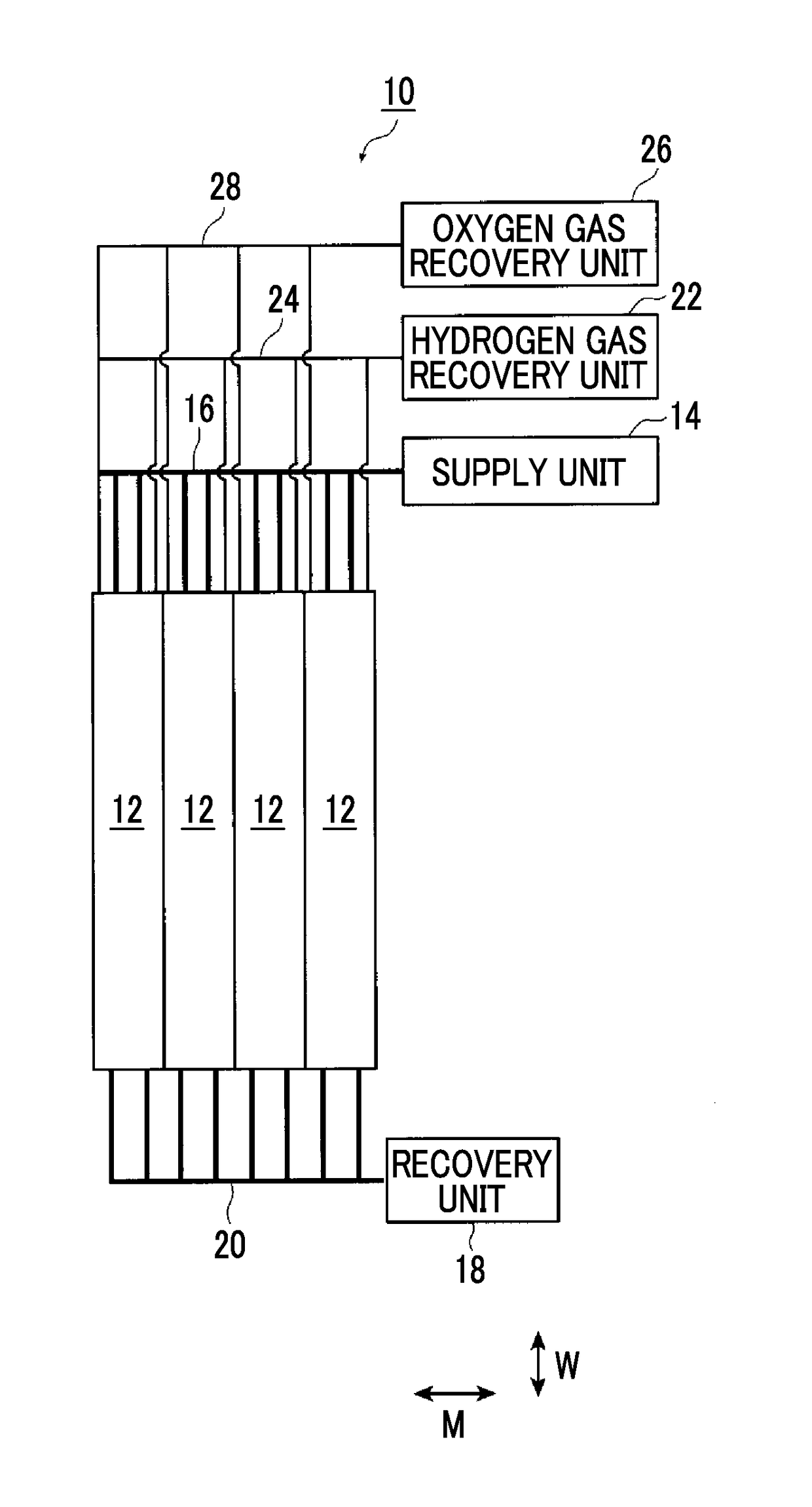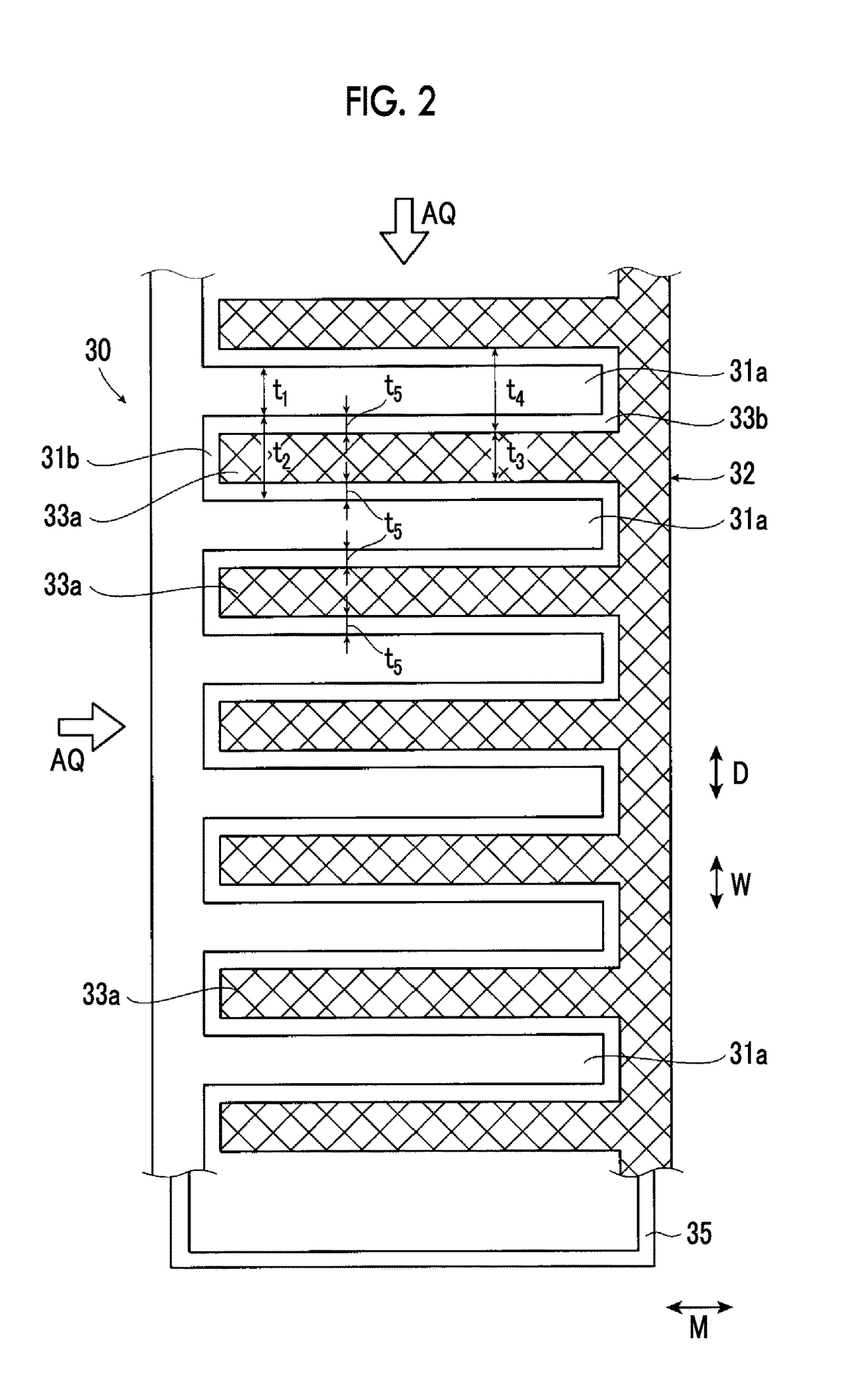Artificial photosynthesis module
a photosynthesis module and photosynthesis technology, applied in the direction of electrolytic capacitors, light-sensitive devices, electrolytic coatings, etc., can solve the problems of poor electrolysis efficiency, poor electrolysis efficiency, water power source requirements, etc., and achieve excellent electrolysis efficiency.
- Summary
- Abstract
- Description
- Claims
- Application Information
AI Technical Summary
Benefits of technology
Problems solved by technology
Method used
Image
Examples
example 1
[0127]An artificial photosynthesis module of Example 1 has a wedge electrode including the hydrogen generation electrode and the oxygen generation electrode illustrated in FIG. 2. In the hydrogen generation electrode and the oxygen generation electrode, respectively, the electrode dimensions are 32 mm×120 mm×Thickness 1.0 mm, comb teeth have Width 3 mm×Length 32 mm×Number of teeth 15, and the width between the comb teeth is 5 mm. The gap spacing of the hydrogen generation electrode and the oxygen generation electrode in a state where the comb teeth of the hydrogen generation electrode and the oxygen generation electrode are made to enter each other is 1.0 mm. The hydrogen generation electrode and the oxygen generation electrode are electrodes (Exeload EA: Japan Carlit Co., Ltd.) obtained by performing platinum plating treatment on the surface of a base material made of titanium. In addition, no ion conduction layer is provided.
[0128]In Example 1, the electrolytic aqueous solution AQ...
example 2
[0137]In a second example, effects of differences between the sizes of electrodes of artificial photosynthesis modules will be described.
[0138]FIG. 9 is a graph illustrating effects of differences between the sizes of the electrodes of the artificial photosynthesis modules.
[0139]In the second example, the effects of differences between the sizes of the electrodes were investigated using Example 1 of the first example, Comparative Examples 1 and 2, and Example 3 to be described below. Specifically, in the present example, the arrival overvoltages when an electric current was made to flow to the artificial photosynthesis modules of Examples 1 and 3 and Comparative Examples 1 and 2at a current density of 8.13 mA / cm2 for 10 minutes were measured. The results are illustrated in FIG. 9.
[0140]In addition, in the present example, a method for measuring arrival overvoltages is the same as the above-described first example, and the same electrolytic aqueous solution as the first example is us...
example 3
[0143]In a third example, effects of differences between the sizes of ion conduction layers of artificial photosynthesis modules will be described.
[0144]FIG. 10 is a graph illustrating effects of the ion conduction layers of the artificial photosynthesis modules.
[0145]In the third example, the effects of the ion conduction layers were investigated using Example 1 of the first example and Example 4 to be described below. Specifically, in the present example, electrolysis voltages (V) when an electric current equivalent to 10% of the conversion efficiency, that is, an electric current of which current density reaches 8.13 mA / / cm2 was made to flow while supplying the electrolytic aqueous solution to the artificial photosynthesis modules of Examples 1 and 4 were measured. The results are illustrated in FIG. 10.
[0146]In addition, the electrolysis voltages are total electric potentials of an anode and a cathode (the hydrogen generation electrode and the oxygen generation electrode) requir...
PUM
 Login to View More
Login to View More Abstract
Description
Claims
Application Information
 Login to View More
Login to View More - R&D
- Intellectual Property
- Life Sciences
- Materials
- Tech Scout
- Unparalleled Data Quality
- Higher Quality Content
- 60% Fewer Hallucinations
Browse by: Latest US Patents, China's latest patents, Technical Efficacy Thesaurus, Application Domain, Technology Topic, Popular Technical Reports.
© 2025 PatSnap. All rights reserved.Legal|Privacy policy|Modern Slavery Act Transparency Statement|Sitemap|About US| Contact US: help@patsnap.com



